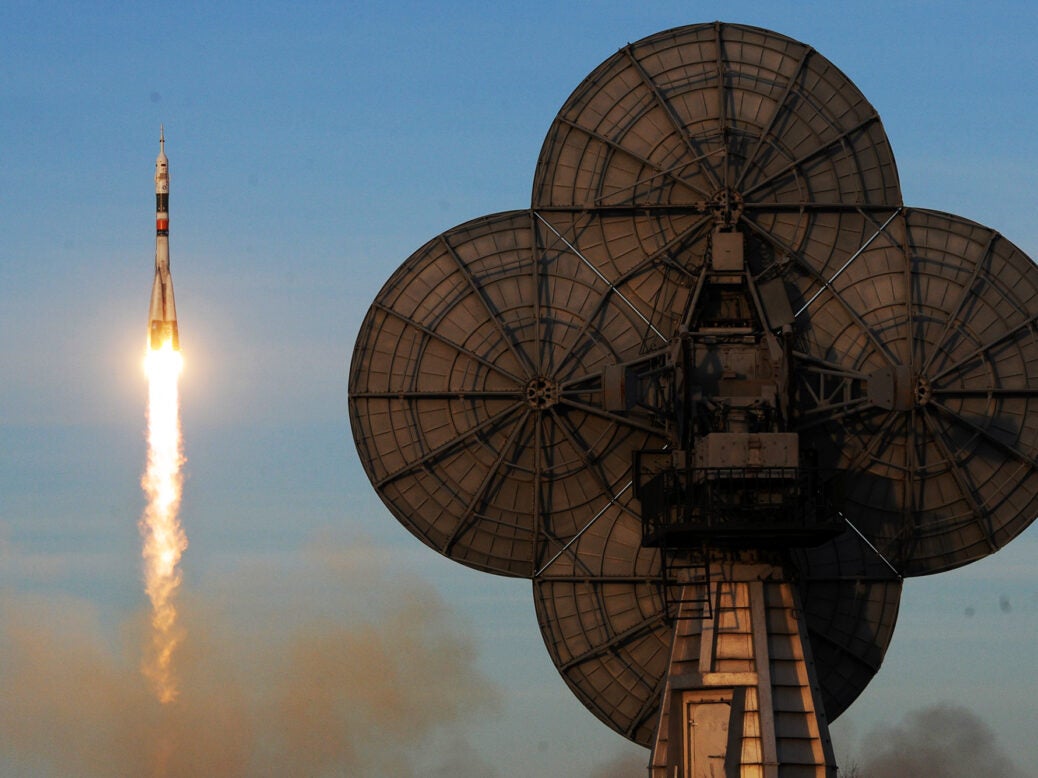How to halt the space arms race

On 15 November astronauts on the International Space Station were ordered to “take refuge” in the spacecraft that had brought them there, as a debris cloud consisting of around 1,500 objects began to whizz past them at about 7.6 kilometres a second.
The cause quickly became clear. Russia had fired a space missile at one of its own defunct satellites, blasting it to smithereens. Diplomatic protests followed: “Russia has demonstrated a deliberate disregard for the security, safety, stability and long-term sustainability of the space domain for all nations,” the US declared.
Using missiles to take out satellites has been a thing since 1958, when the US began experimenting with rockets launched from high-altitude jets. Today, the US, Russia, India and China have anti-satellite missile capabilities. But ground-launched missiles are not the only way to take down competitors’ satellites: all the major space powers are also experimenting with lasers, microwaves, manoeuvrable jamming satellites and cyber attacks.
Suddenly “space war” has become an obsession of countries with the resources to prosecute it, the UK included. Ours is a different world to the one envisaged by the UN Outer Space Treaty, signed in 1967, in which space was “free” and astronauts “envoys of mankind”. There are no satellites yet, as far as we know, armed with kinetic weapons. But all major military powers are engaged in an arms race over the ability to watch, communicate with and guide weapons from space – and to take out each other’s satellites.
On the face of it, compared to the conventional wars that scar terrestrial reality, the concept of space war sounds clinical. If it killed anyone at all it would be a few astronauts. But the stakes of modern space conflict are in fact enormous: since the 1991 Gulf War, satellites have become the crucial enablers of modern warfare. Their real-time, high-resolution imagery allows commanders to see the entire Earth as a battlefield without hiding places. Their encrypted comms can place naval HQs in real-time touch with ships and submarines anywhere on Earth. They can jam the navigation systems of super-tankers. Their interception capacities can hoover up the smartphone traffic of an entire country. Any military force “enabled” (in military-speak) by satellites – whether fighting on land, sea or in the air – can disperse its forces more effectively than its non-space adversary and yet concentrate firepower more effectively.
Little wonder, then, that the must-have capability is now a weapon that can disable your opponent’s satellite. Kill the satellites, says modern military theory, and the Russian Spetsnaz, the US warship or the British tank company is suddenly blundering around blindly, like its Second World War predecessors, reliant on paper maps, compasses and the stars.
During the past decade, the arms race in space has accelerated for an obvious reason. We are no longer in the “unipolar” world once celebrated by American neo-cons, with the US the unchallenged superpower. China has poured vast resources into its navy, which now outnumbers that of the US in terms of fighting ships and submarines. Russia has modernised all three traditional dimensions of warfare, and become dominant and aggressive in the use of a fourth – cyberwar. Conventional warfare between “peers” – ie, big, nuclear armed states – is unfortunately now thinkable.
Defence planners have thus begun to see space less as an “enabler” of terrestrial armed forces and more as a domain of warfare in its own right. In 2019 Donald Trump re-tasked the Air Force Space Command as the US Space Force, creating an entirely separate command structure for war in space. France followed suit, announcing its intent to form a space command and to develop “bodyguard satellites” to protect its military satellites. In 2019 India joined Russia, China and the US in the elite club of nations demonstrating the capability to vapourise a satellite with a missile.
Could space be demilitarised? Not a chance, say the experts, who point out that – in contrast to the space exploration of the popular imagination, where it is still seen as a benign, trans-national endeavour – the entire history of space technology, from the Nazi V2 rocket to the recent Russian anti-satellite strike, has been driven by the military.
Yet military activity in space could be made more orderly and transparent. The two most authoritative annual reports on military space capabilities are both reliant on open-source information and acknowledge that there are huge gaps in what even the experts know. We know how many satellites are up there: we do not know much about what weapons they might carry.
This stands in contrast to the way the rival superpowers have managed both nuclear and conventional deterrence since the onset of the Cold War, with a series of treaties signed by Russia and the West to minimise or regulate aggression – for example, limiting the possession of nuclear weapons or the deployment of armoured vehicles. But there is almost no such framework for regulating the space arms race, or for achieving basic transparency about who’s doing what, still less for avoiding conflict.
US and Russian space commanders convened in Vienna last July, agreeing to “enhance communications between the two countries about space-related operational issues in order to reduce the risks of misunderstanding, help prevent or manage space-related incidents, and prevent inadvertent escalation”. This did not stop Russia’s surprise launch of an anti-satellite missile on 15 November, nor did it avert the war of words that followed it. In truth the US-Russia space dialogue, a hangover from the Cold War, is a long way from the multilateral and comprehensive framework needed to bring China, India, Israel and Iran around the table.
Lacking any formal international treaty beyond the anti-nuclear one, space has, in effect, become a demonstration zone for geopolitical realism. Those who have real power on Earth have untrammelled power in space. They will zap their own satellites at will, buzz the satellites of others, launch “projectiles” from existing satellites – as Russia allegedly did last year – and unleash spoofing attacks to disorient civilian shipping, all without acknowledgement or explanation. The emerging field of space war looks, in other words, exactly like terrestrial conflict would if there were no treaties and deployment patterns, or journalists and NGOs to observe them.
This year the UK launched its own space command, with military chiefs acknowledging space as a domain of conflict co-equal with air, land, sea and cyber. Britain is late to the space war game and, after years of offshoring and outsourcing, lacks the expertise and resources to compete with the big four space powers: it doesn’t figure in either of the monitoring reports on space militarisation documenting significant offensive capabilities. As a medium-sized power, self-excluded from large parts of the EU’s space programmes, it is in Britain’s interest to promote order, multilateralism and transparency in space, and to resist its further militarisation. And, to an extent, haltingly, it has done so, promoting the first real debate at the UN over a new space treaty.
Yet space demilitarisation remains at the concept stage. On 1 November 180 states meeting at the UN approved five draft resolutions on the demilitarisation of space – with Russia, China and their allies voting against the most comprehensive draft, pushed by the UK and the US. Russia’s position remains that until the West is prepared to sign a binding legal instrument totally demilitarising space (and thus foregoing decades of the US’s advantage in the arms race), it will oppose the various voluntary agreements and transparency projects on offer.
We are stuck. And while polite verbal fencing takes place at the UN, the major powers of the 21st century are engaged in an unprecedented expansion of military power in space, leaving the vast majority of countries powerless, most of humanity as passive spectators, and the Earth’s orbit increasingly polluted with debris from exploded satellites.





